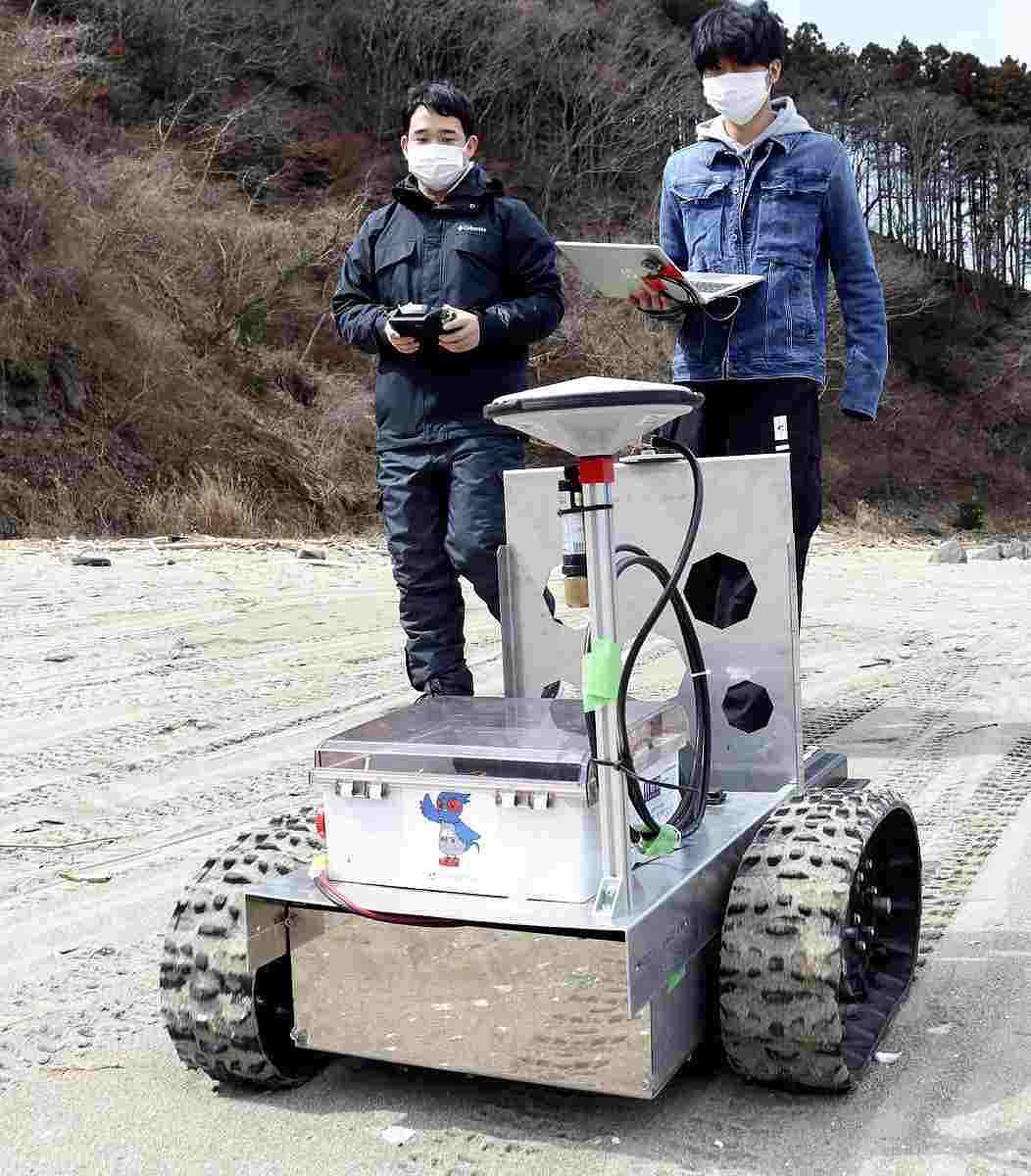
Students search for the personal effects and remains of tsunami victims using a robot equipped with ground-penetrating radar in Ishinomaki, Miyagi Prefecture, on Sunday.
14:12 JST, March 20, 2023
SENDAI — A technical college in Sendai has developed a self-propelled robot equipped with ground-penetrating radar, which it recently deployed to search for four elementary school children missing since the tsunami that followed the 2011 Great East Japan Earthquake.
The search was conducted Sunday on the coast of Ishinomaki, Miyagi Prefecture, at the request of Miho Suzuki, 54, whose daughter Hana went missing from the disaster as a fourth grader at Okawa Elementary School.
“It’s OK if it takes some time, but I want them to find Hana at any cost,” Suzuki said watching over the search, her face fixed as though in prayer.
Prof. Jun Sonoda, 52, of National Institute of Technology Sendai College, converted a snowplow to build the 120-centimeter-long, 70-centimeter-wide, 70-centimeter-tall robot. Its continuous tracks allow it to travel over rocky terrain, and it can accurately locate itself using the global positioning system.
The latest search was conducted on a 200-meter stretch of sandy beach near the Nagatsura bathing beach on the east side of the elementary school, with ground-penetrating radar being used to scan 1 meter down. Buried objects were detected at about 10 locations, and volunteers plan to dig up and examine them in mid-April.
Sonoda initially developed a hand-pulled device equipped with ground-penetrating radar, and began conducting searches in 2013 in Natori, Miyagi Prefecture, and Rikuzentakata, Iwate Prefecture. In 2021, he produced a self-propelled robot with tires, a build that would go through four more iterations before being deployed for Sunday’s search.
So far, Sonoda’s successive robots have found about 30 items, including hats and shoes with names on them. To increase the odds of an important find, a data set has been created of some 100,000 items that are not personal effects or remains that includes information on object size and shape. This allows artificial intelligence to determine what an item is while it lies still buried, and frees up search parties to dig only in promising spots.
Since the disaster 12 years ago, Suzuki has gone to the beach near her daughter’s school once or twice a month to dig for signs of Hana, but she had felt that it would be “nearly impossible” to turn over the whole beach by hand.
After Sunday’s search, Suzuki said she was “happy to hear that the robot picked up multiple hits.”
“Twelve years have passed since the earthquake,” said Sonoda, “and fewer people are volunteering for searches. In the future, I hope to contribute to searches by building a robot that can dig by itself.”
This summer, the robot is scheduled to search for those who went missing during the Mt. Ontake eruption that occurred in September 2014 in Nagano and Gifu prefectures.
Related Tags
"Society" POPULAR ARTICLE
-

M4.9 Earthquake Hits Tokyo, Neighboring Prefectures
-

M7.5 Earthquake Hits Northern Japan; Tsunami Waves Observed in Hokkaido, Aomori and Iwate Prefectures
-

Tsukiji Market Urges Tourists to Avoid Visiting in Year-End
-

Israeli Tourists Refused Accommodation at Hotel in Japan’s Nagano Pref., Prompting Protest by Israeli Embassy and Probe by Prefecture
-

M5.7 Earthquake Hits Japan’s Kumamoto Pref., Measuring Upper 5 Intensity, No Tsunami Expected
JN ACCESS RANKING
-

Keidanren Chairman Yoshinobu Tsutsui Visits Kashiwazaki-Kariwa Nuclear Power Plant; Inspects New Emergency Safety System
-

Imports of Rare Earths from China Facing Delays, May Be Caused by Deterioration of Japan-China Relations
-

University of Tokyo Professor Discusses Japanese Economic Security in Interview Ahead of Forum
-

Japan Pulls out of Vietnam Nuclear Project, Complicating Hanoi’s Power Plans
-

Govt Aims to Expand NISA Program Lineup, Abolish Age Restriction






















